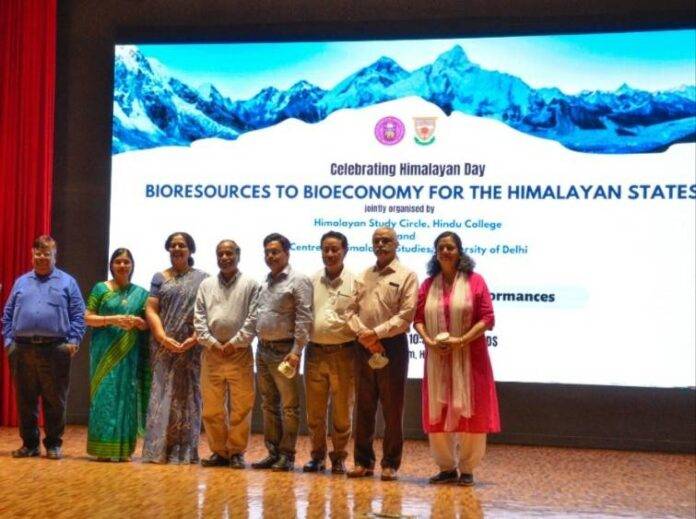New Delhi: A beautiful range of thousands of hills in the Himalayas attracts nature lovers for enormous hidden innumerable secrets, hence many literatures have been written on the glory of the Himalayas and today prominent environmentalists, geographers and scientists are telling its importance to the world through extensive research. But the Himalayan Mountains are experiencing new challenges and going through rapid changes due to unplanned development for the economic growth of the Himalayan region. The result is frequent melting of glaciers, loss of habitats, landslides and floods, etc. These were the prime concerns shared by several erudite experts in a wide-reaching gathering of around eight hundred young students, researchers and distinguished faculty members of Delhi University during the grand celebration of ‘Himalayan Day’ with the theme ‘Bioresources to Bioeconomy for the Himalayan states.’ This event was jointly organized by the Centre for Himalayan Studies, University of Delhi and Himalayan Study Circle, Hindu College, University of Delhi.
The informative Panel Discussion was chaired by the Director of the Centre for Himalayan Studies Prof. Dinabandhu Sahoo and the Panelists Mr. C. K. Nayak, President of Press Association and Dr. K. K. Jha, IFS emphasized how bioresources can be effectively used to boost the economy of the Himalayan region. Explaining to the vibrant young minds, Prof. Dinabandhu Sahoo said ‘Biobased economy is the solution for the growth and development of the Himalayan states. The bioeconomy has the potential to create new jobs and can generate new solutions for the planet’s major challenges in the field of health, food, water, and climate change and can deliver social, environmental and economic benefits. Himalaya is our common Heritage, and all entire humanity should try and contribute to saving Himalaya. The region has several plants, animals and microorganisms, which can be used to set biobased industries in the Himalayan states. Bioeconomy is a relatively new concept and rapidly developing in several nations. India can be a major player with it’s unique resources from the Himalayan region, especially from North Eastern Himalayas.’
Principal of Hindu College Prof. Anju Srivastava said ‘Hindu College has always been doing public awareness in society on the issues of environmental conservation. Our students are nature lovers and always try to convey the culture of many states related to the Himalayas to other students as well. We have a special plan for the study and research of the culture and biodiversity of the Himalayas, under which our students will soon undertake an educational tour of the Himalayas.’
‘Our college students are ready to work in the Himalayas. On this special day, the students displayed the culture of different states through various activities. Every student of the College is very close to nature and the environment and understands the responsibility of its conservation. Our plan is that more and more students understand the Himalayan culture through science and research and our endeavor is to conserve the biodiversity of the Himalayas and encourage the youth to connect with the nature of Himalayas.’ stated Dr. Anuradha Sharma, coordinator of the Himalayan Study Circle of Hindu College.
Prof. Reena Jain, Vice Principal, Hindu College, Prof. Bijayalaxmi Nanda, Principal of Miranda House and other scholarly dignitaries attended the event at the newly built Sanganeria auditorium, of the College. The other theme-based activities were also held which included a Photography, poster-making and reel-making competition in which the students of other colleges of Delhi University participated. The enthusiastic students and volunteers of the Panchtatva environment society of the College coordinated the event with their innovative idea and research. The mesmerizing cultural performances were showcased by the North East Cell of the College.










